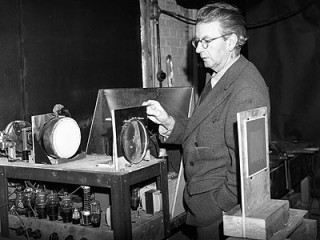
John Logie Baird biography
Date of birth : 1888-08-13
Date of death : 1946-06-14
Birthplace : Helensburgh, West Dunbartonshire, Scotland
Nationality : Scottish
Category : Arhitecture and Engineering
Last modified : 2011-09-28
Credited as : engineer, businessman, television inventor
4 votes so far
His development of a photo-electric cell was the crucial breakthrough that allowed him to transmit more than merely shadows. On 26 January 1926 he gave the first public demonstration of moving pictures over his television system, showing recognizable human faces with an array of expressions, as a few dozen scientists watched at the Royal Institution. Funding was soon secured, and he established the Baird Television Development Company in 1927, and sent television images across more than 400 miles of wires between London and Glasgow. The following year he accomplished the first trans-Atlantic television transmission, reaching an amateur radio operator in Hartsdale, New York with a signal broadcast from London. His company provided the British Broadcasting Corporation (BBC)'s first TV program, aired on 30 September 1929. His system broadcast audio and visual components in an alternating pattern, but in 1930 he successfully sent both signals simultaneously.
By the early 1930s, however, competing systems of television were showing more success, and in a 1935 test against Vladimir Zworykin's system (backed by Guglielmo Marconi's Electric and Musical Industries) the BBC deemed Zworykin's system superior. As corporations like MCI and RCA became involved in the television industry, Baird's do-it-yourself technology was soon forgotten. He also conducted early but important work on the technology that evolved into radar and fiber optics, and he invented phonovision (a video recorded based on a mechanical scanner), noctovision (an infra-red based system for night vision), and the "Baird Undersock", a footwear shield that he promoted as guaranteeing dry feet even in wet weather.
















